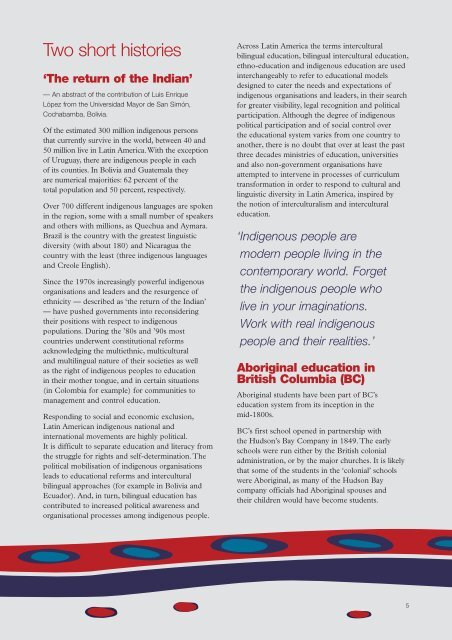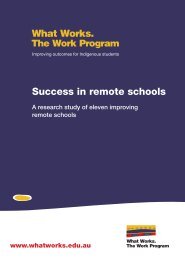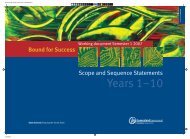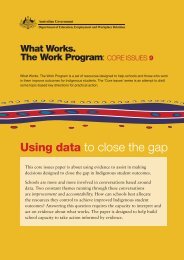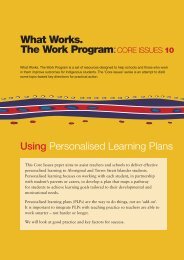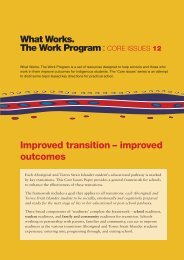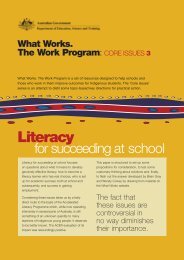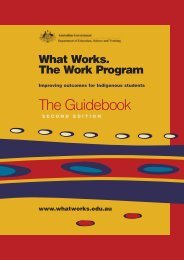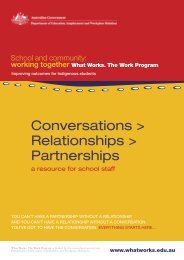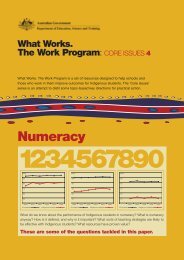Indigenous education: International perspectives - What Works
Indigenous education: International perspectives - What Works
Indigenous education: International perspectives - What Works
You also want an ePaper? Increase the reach of your titles
YUMPU automatically turns print PDFs into web optimized ePapers that Google loves.
Two short histories<br />
‘The return of the Indian’<br />
— An abstract of the contribution of Luis Enrique<br />
López from the Universidad Mayor de San Simón,<br />
Cochabamba, Bolivia.<br />
Of the estimated 300 million indigenous persons<br />
that currently survive in the world, between 40 and<br />
50 million live in Latin America.With the exception<br />
of Uruguay, there are indigenous people in each<br />
of its counties. In Bolivia and Guatemala they<br />
are numerical majorities: 62 percent of the<br />
total population and 50 percent, respectively.<br />
Over 700 different indigenous languages are spoken<br />
in the region, some with a small number of speakers<br />
and others with millions, as Quechua and Aymara.<br />
Brazil is the country with the greatest linguistic<br />
diversity (with about 180) and Nicaragua the<br />
country with the least (three indigenous languages<br />
and Creole English).<br />
Since the 1970s increasingly powerful indigenous<br />
organisations and leaders and the resurgence of<br />
ethnicity — described as ‘the return of the Indian’<br />
— have pushed governments into reconsidering<br />
their positions with respect to indigenous<br />
populations. During the ’80s and ’90s most<br />
countries underwent constitutional reforms<br />
acknowledging the multiethnic, multicultural<br />
and multilingual nature of their societies as well<br />
as the right of indigenous peoples to <strong>education</strong><br />
in their mother tongue, and in certain situations<br />
(in Colombia for example) for communities to<br />
management and control <strong>education</strong>.<br />
Responding to social and economic exclusion,<br />
Latin American indigenous national and<br />
international movements are highly political.<br />
It is difficult to separate <strong>education</strong> and literacy from<br />
the struggle for rights and self-determination. The<br />
political mobilisation of indigenous organisations<br />
leads to <strong>education</strong>al reforms and intercultural<br />
bilingual approaches (for example in Bolivia and<br />
Ecuador). And, in turn, bilingual <strong>education</strong> has<br />
contributed to increased political awareness and<br />
organisational processes among indigenous people.<br />
Across Latin America the terms intercultural<br />
bilingual <strong>education</strong>, bilingual intercultural <strong>education</strong>,<br />
ethno-<strong>education</strong> and indigenous <strong>education</strong> are used<br />
interchangeably to refer to <strong>education</strong>al models<br />
designed to cater the needs and expectations of<br />
indigenous organisations and leaders, in their search<br />
for greater visibility, legal recognition and political<br />
participation. Although the degree of indigenous<br />
political participation and of social control over<br />
the <strong>education</strong>al system varies from one country to<br />
another, there is no doubt that over at least the past<br />
three decades ministries of <strong>education</strong>, universities<br />
and also non-government organisations have<br />
attempted to intervene in processes of curriculum<br />
transformation in order to respond to cultural and<br />
linguistic diversity in Latin America, inspired by<br />
the notion of interculturalism and intercultural<br />
<strong>education</strong>.<br />
‘<strong>Indigenous</strong> people are<br />
modern people living in the<br />
contemporary world. Forget<br />
the indigenous people who<br />
live in your imaginations.<br />
Work with real indigenous<br />
people and their realities.’<br />
Aboriginal <strong>education</strong> in<br />
British Columbia (BC)<br />
Aboriginal students have been part of BC’s<br />
<strong>education</strong> system from its inception in the<br />
mid-1800s.<br />
BC’s first school opened in partnership with<br />
the Hudson’s Bay Company in 1849. The early<br />
schools were run either by the British colonial<br />
administration, or by the major churches. It is likely<br />
that some of the students in the ‘colonial’ schools<br />
were Aboriginal, as many of the Hudson Bay<br />
company officials had Aboriginal spouses and<br />
their children would have become students.<br />
5


